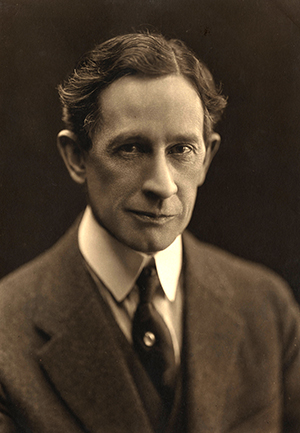24 Oct. 1872–27 June 1953

William Chambers Coker, university professor, was born in Hartsville, S.C. His father, Major James Lide Coker, born at nearby Society Hill, was educated at the Citadel in Charleston and spent one year at Harvard working with Asa Gray and Louis Agassiz. The major, one of South Carolina's most successful businessmen, was also a leader in education, helping in the establishment of the public school system in South Carolina and founding Coker College for Women at Hartsville. William's mother, Susan Armstrong Stout, was the daughter of the Reverend Platt Stout, a Baptist minister of Carlowville, Ala.
From Coker's early childhood, his interest in nature was shared and encouraged by his father. His early schooling was given by a tutor in the Coker home, and later he attended a small college preparatory school in Hartsville. He entered the University of South Carolina in 1891, being graduated in 1894. That year he began working as a runner in the Atlantic National Bank at Wilmington, N.C., where he rose to become one of the vice-presidents in 1896. In 1897 he decided to give up banking and do graduate work at Johns Hopkins University. After receiving the Ph.D. with high distinction in 1901, he spent a semester in Eduard Strasburger's laboratory at Bonn-am-Rhine, Germany. In the fall of 1902 he joined the faculty of The University of North Carolina as associate professor of botany, and there he served continuously until his retirement in 1945.
In the Chapel Hill area, Coker found a region rich botanically but largely unexplored. He began work on the local flora and published within a year a list of the woody plants of Chapel Hill. This interest, continued and expanded with the help of H. R. Totten, led to the publication of Trees of North Carolina in 1916 and of Trees of the Southeastern States in 1934 (3rd ed., 1945). Coker's other important publications on the higher plants were Vegetation of the Bahama Islands (1905) and The Plant Life of Hartsville, S.C. (1912). In its ecological treatment, the latter was significantly ahead of its time. His papers on teaching science in the high schools, the Venus flytrap, algae, bryophytes, and ferns, as well as several exceedingly interesting sketches of the lives of southern botanists, show the great diversity of his interests.
During a period of about 51 years, Coker produced 137 publications. As a botanist, however, he will be remembered longest for his researches on fungi. Out of 58 publications on fungi, the most noteworthy are "The Amanitas in the Eastern United States", The Clavarias of the United States and Canada, "The Gasteromycetes of the United States and Canada" (with J. N. Couch), The Boletaceae of North Carolina and The Stipitate Hydnums of the Eastern United States (the last two with Alma Holland Beers). In spite of his prodigious researches on the higher fungi, Coker's reputation as a mycologist rests largely on his work on the Saprolegniaceae, begun in 1908 and reaching its climax in the 1923 publication of The Saprolegniaceae, a work that has had world-wide influence in stimulating researches on the aquatic fungi.
All five of Coker's books were first published by The University of North Carolina Press, and all were later reprinted by commercial houses.
Coker's eminence as a botanist brought him honors too numerous to list. Briefly, he was elected chairman of the Mycological Section of the Botanical Society of America in 1927; in 1950 he was vice-president of the Mycological Section of the Sixth International Plant Congress at Stockholm, Sweden; and he was the first chairman of the Southeastern Section of the Botanical Society of America.
Coker also had a remarkable talent in landscape architecture, which he constantly improved by study and practice. Soon after he arrived in Chapel Hill he obtained permission of the university authorities to develop about six acres of boggy wasteland on what was then the eastern edge of the campus, the present Coker Arboretum. This unsightly area was gradually transformed into a natural garden featuring mostly native shrubs and trees. For thirty years, Coker was chairman and the inspiration of the Building and Grounds Committee, and his good judgment and taste were reflected in dignified, uncrowded buildings softened by informal plantings. For several years he carried on experiments with grasses in an attempt to find a mixture of seed suitable to keep the lawns of Chapel Hill green throughout the year. When finally a mixture was selected, a pamphlet was published telling in great detail how to prepare and fertilize the ground and plant the seed.
Coker's major interest in teaching was the course in general botany, and as an undergraduate instructor he ranked high. The excellence of the laboratories was due mainly to his insistence that the students have plenty of fresh and interesting plant material with which to work, and field trips were used to supplement lectures and the laboratory.
Coker's advanced classes rarely had more than three or four students, each of whom had a table in the research laboratory along with the professor. Such small classes were conducted informally, the students doing the lecturing by giving reports of research papers related to the work being done in the laboratory. Coker was never too hurried to look at something of interest a student had found, and he had a rare ability to stimulate the student to want to find out more for himself and to believe in the importance of what he was doing. This inspirational power derived partly from Coker's own sense of his work as important. Until his health began to fail, he devoted himself almost entirely to it, and one of his most distinctive characteristics was his single-minded devotion to his work.
Coker remained a bachelor until 28 Oct. 1934, when he married Louise Manning Venable, daughter of President Francis P. Venable.